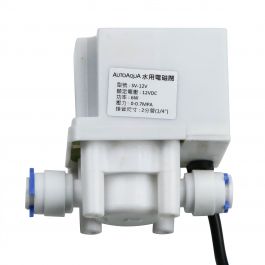Hi there,
I'm putting up an RO/DI unit at my school (likely a Spectrapure 4-stage with built-in TDS, manual flush, pressure gauge, etc.). Logistically, I don't have the cash or space (yet) to build a full-on water station (with a large pump, quality valves, plumbing, vertical Norwesco containers, etc.). I also likely can't use the adjacent washroom (only 10 feet away) as a holding place for the RO/DI unit due to public traffic. Thus, I'm considering a short term solution of two 32 gallon brutes on wheels, with the RO/DI unit in my classroom behind my desk affixed to the wall. I'm thinking I could use a booster pump (Aqua Fx perhaps) to send a 1/4'' RO line into my classroom from the bathroom, with a waste line heading back and plumbed into the drainpipe under the sink.
Need your insights on this, big picture and micro-details:
1. Is it ok to place the RO/DI unit in a room that is separate from the water source/sink (~10 feet away + wall)? Pros and cons?
2. Is there an optimal height to install an RO/DI unit on the wall to mitigate problems? 4-5 feet it appears from other forums.
3. Best booster pump for this particular job? The Aquatic Life has great reviews but would require me to change up the lines in the Spectrapure unit I'm told. The Aqua Fx would not require this I gather. Either way, should be ~ simple to plumb in.
4. What sort of added features would enhance this setup? In-line ball valves in the classroom for quick turn off, for example? (Obviously mechanical and optical devices to prevent floods).
5. To mix saltwater, I'm looking at a ~quality DC pump that could serve as a backup to my Ecotech Vectra S2 primary display tank pump (1'' input, 0.75' output). The Jebao DCP 5000 seems about right. This is a pretty heavy-duty pump advertised at 855-1320 GPH. While perhaps a good backup pump, I'm wondering if 855 gph is overkill to add water to my display tank (peninsula, 100 gallons, 49x22x23 with a decent-sized sump) and for mixing saltwater in a 32-gallon tank?
6. Also wondering if a quick-swap of the two DC pumps is possible because the Vectra S2 requires some gluing and has some ~negative reports of sanding required on one of the adapters.
Thanks all for any insights - much appreciate this community forum.
Cheers
I'm putting up an RO/DI unit at my school (likely a Spectrapure 4-stage with built-in TDS, manual flush, pressure gauge, etc.). Logistically, I don't have the cash or space (yet) to build a full-on water station (with a large pump, quality valves, plumbing, vertical Norwesco containers, etc.). I also likely can't use the adjacent washroom (only 10 feet away) as a holding place for the RO/DI unit due to public traffic. Thus, I'm considering a short term solution of two 32 gallon brutes on wheels, with the RO/DI unit in my classroom behind my desk affixed to the wall. I'm thinking I could use a booster pump (Aqua Fx perhaps) to send a 1/4'' RO line into my classroom from the bathroom, with a waste line heading back and plumbed into the drainpipe under the sink.
Need your insights on this, big picture and micro-details:
1. Is it ok to place the RO/DI unit in a room that is separate from the water source/sink (~10 feet away + wall)? Pros and cons?
2. Is there an optimal height to install an RO/DI unit on the wall to mitigate problems? 4-5 feet it appears from other forums.
3. Best booster pump for this particular job? The Aquatic Life has great reviews but would require me to change up the lines in the Spectrapure unit I'm told. The Aqua Fx would not require this I gather. Either way, should be ~ simple to plumb in.
4. What sort of added features would enhance this setup? In-line ball valves in the classroom for quick turn off, for example? (Obviously mechanical and optical devices to prevent floods).
5. To mix saltwater, I'm looking at a ~quality DC pump that could serve as a backup to my Ecotech Vectra S2 primary display tank pump (1'' input, 0.75' output). The Jebao DCP 5000 seems about right. This is a pretty heavy-duty pump advertised at 855-1320 GPH. While perhaps a good backup pump, I'm wondering if 855 gph is overkill to add water to my display tank (peninsula, 100 gallons, 49x22x23 with a decent-sized sump) and for mixing saltwater in a 32-gallon tank?
6. Also wondering if a quick-swap of the two DC pumps is possible because the Vectra S2 requires some gluing and has some ~negative reports of sanding required on one of the adapters.
Thanks all for any insights - much appreciate this community forum.
Cheers
















